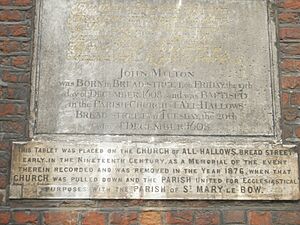All Hallows, Bread Street facts for kids
Quick facts for kids All Hallows Bread Street |
|
|---|---|
 |
|
| Location | Watling Street, London |
| Country | England |
| Denomination | Anglican |
| Architecture | |
| Architect(s) | Christopher Wren |
| Style | Baroque |
| Demolished | 1876 |
All Hallows Bread Street was a historic parish church in the City of London, England. It stood on the corner of Bread Street and Watling Street. The church was first mentioned in the 1200s. Sadly, it was destroyed in the Great Fire of London in 1666. Later, it was rebuilt by the famous architect Sir Christopher Wren's team. The church was eventually taken down in 1876.
Contents
A Look Back at All Hallows Bread Street
The name All Hallows means "all saints." This suggests the church might have been built a very long time ago, possibly in Saxon times. However, the first official record of it is from 1227. Bread Street got its name because it was where bread was sold in medieval London. "Cheap" in Cheapside, a nearby main street, also meant "market."
For many years, the church was supported by the Christ Church in Canterbury. But in 1365, this support was given to the Archbishop of Canterbury.
The Old Church Building
The church was made bigger in 1349 and 1350. A man named Thomas Beaumont, who was part of the Salter's company, built a special chapel inside. This chapel was on the south side of the main church area. It became known as the "Salter's Chapel."
The church used to have a tall stone spire. In 1559, lightning hit the spire. It wasn't badly damaged, but it was taken down to save money on repairs.
In 1555, during the time of Queen Mary I, the church's leader, Laurence Saunders, was executed for his religious beliefs. He was a Protestant and was burned at the stake. The famous writer John Milton was christened, or baptized, at All Hallows Bread Street in 1608. A stone plaque now marks this event at St Mary-le-Bow church.
Weekly Sermons
A merchant named Ellyot, who passed away in 1629, left money for a sermon to be given every Thursday afternoon. This tradition continued for a long time. It only stopped in the 1800s because not enough people were coming to listen.
Rebuilding After the Great Fire
After the Great Fire of London destroyed the church, its area was joined with another nearby church's area. This was the parish of St John the Evangelist Friday Street. That church was also destroyed but was never rebuilt.
In 1671, a temporary church was set up for people from both areas. The rebuilding of All Hallows Bread Street started in 1681. By 1684, the main part of the church was finished. However, the tower was not yet complete. Work stopped because Sir Christopher Wren was busy building many churches. He was also working on the huge St Paul's Cathedral.
In 1697, the Lord Mayor, Edward Clarke, asked Wren to finish the steeple. Soon after, work started again, and the tower was completed the next year. The whole church cost about £4,881 to build. Records show that Wren and his assistant, Nicholas Hawksmoor, were given wine for their efforts.
The rebuilt church faced north towards Watling Street. It had eight round-topped windows. The church's shape was a bit unusual, like a slightly uneven square. Its walls were topped with a decorative railing called a balustrade.
The church was about 72 feet long and 35 feet wide. Inside, there were no large pillars. There was a balcony at the west end with an organ. This organ was paid for by donations in 1717. Later, a smaller balcony was added on the south side. At the east end, there was a special area for the altar screen, called a reredos. The Royal Arms were displayed above it.
The steeple, finished 14 years later, was designed by Nicholas Hawksmoor. The tower was square. Its top part had three arched openings on each side. Each opening had a finely carved face. The very top had a balustrade with four stone pillars, called obelisks, at the corners.
The Church's Final Years
By the late 1800s, fewer people lived in the church's area. Many had moved to the suburbs. So, in 1876, the area of All Hallows Bread Street was combined with St Mary-le-Bow. The church building was then taken down in 1878.
The land and building materials were sold for £32,254. This money was used to build a new church called All Hallows East India Dock Road. Parts of the old church were moved to other churches. The pulpit is now in St Vedast alias Foster. The organ case is in St Mary Abchurch. The font cover is in St Andrew-by-the-Wardrobe.
Today, the site where the church once stood is covered by modern buildings.
Images for kids




